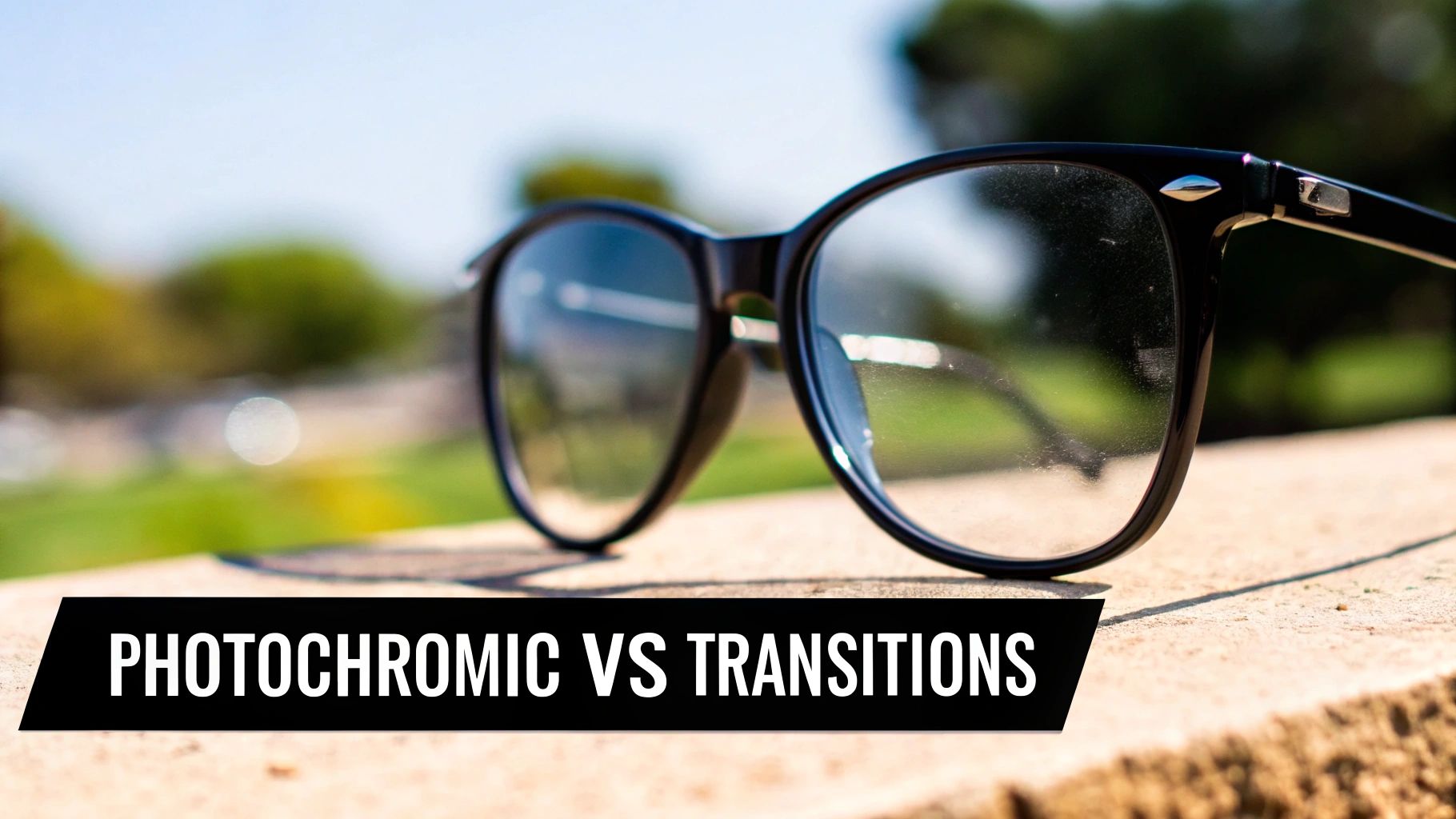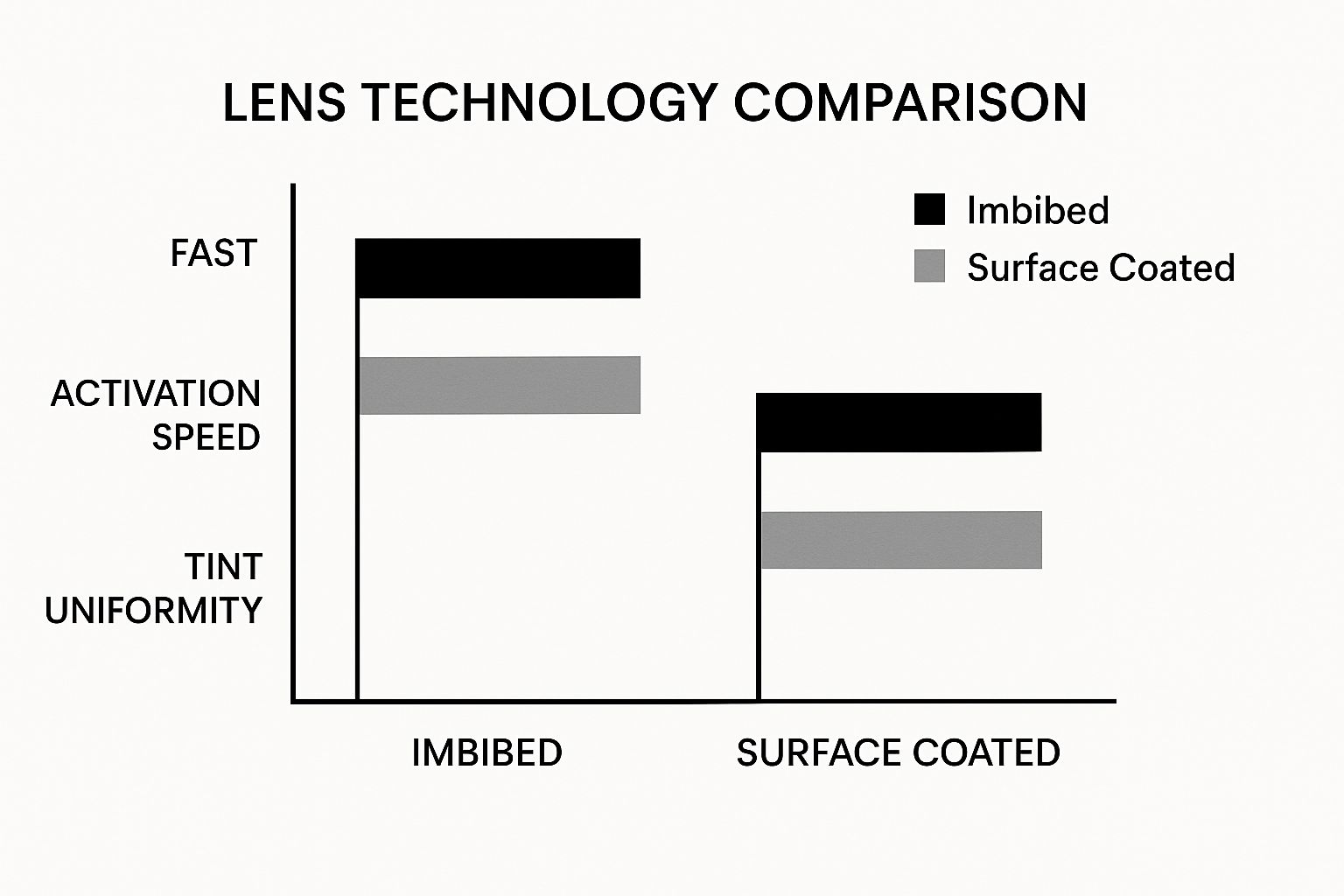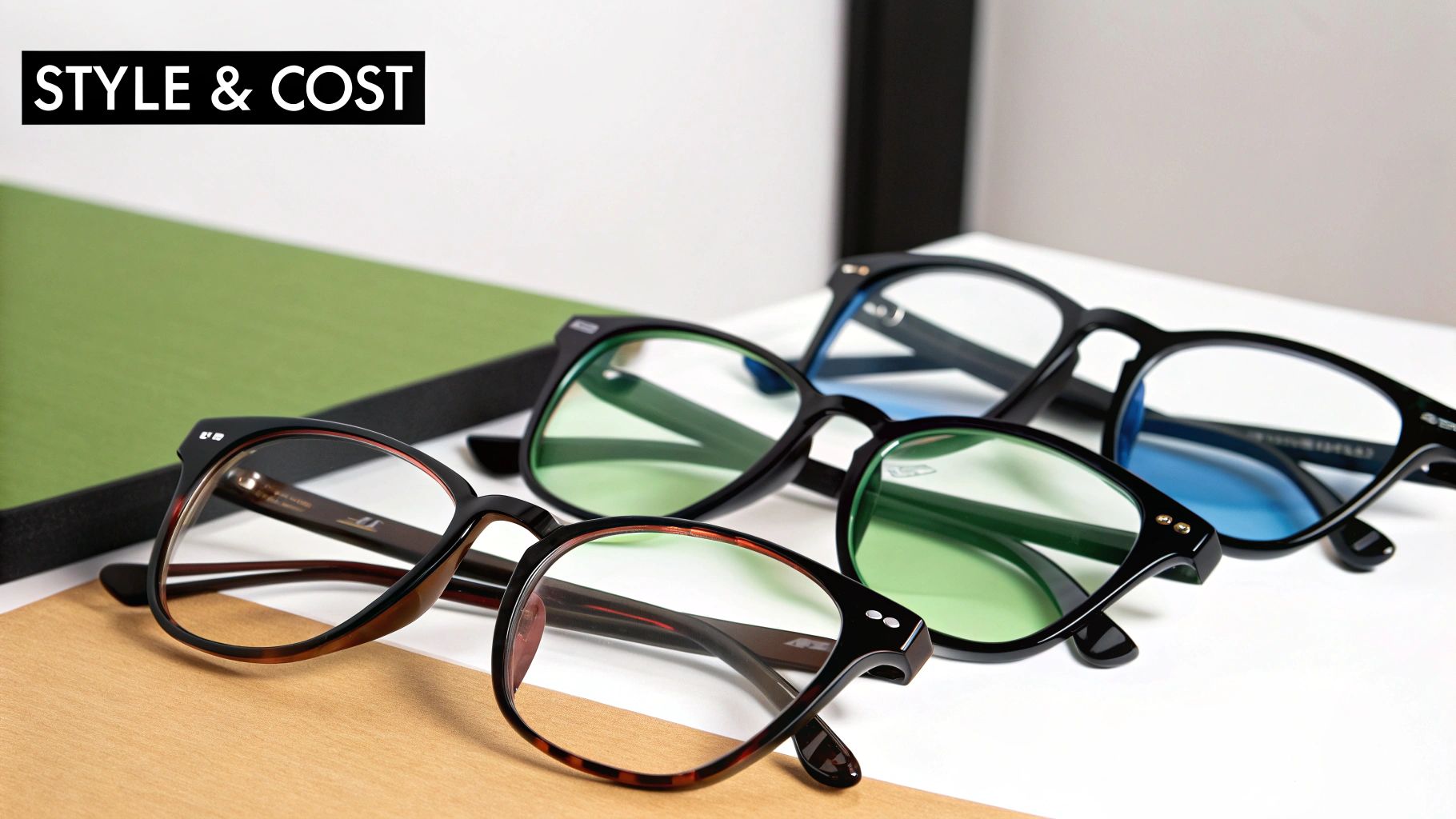Let's get one thing straight from the jump: photochromic lenses is the blanket term for any lens that darkens in sunlight. Transitions is simply the biggest brand name making that technology.
It's a classic case of Kleenex versus tissues. All Transitions lenses are photochromic, but not every photochromic lens you find will be a Transitions-branded one. Knowing this difference is the key to protecting your eye health and picking the right specs for your safety.
Your Guide to Light Adaptive Lenses

Here in Australia, with our intense sun, adaptive lenses aren't just a nice-to-have; they’re a vital piece of kit for your eye health. They give you instant, seamless protection from high UV exposure the moment you step outside. Imagine walking out of a shopping centre into a bright car park; instead of fumbling for sunglasses while squinting, your lenses automatically darken, protecting your eyes immediately. It's a practical, all-in-one solution that safeguards your vision.
It's no surprise that the demand for this convenience and UV protection is skyrocketing. The global market for photochromic lenses is currently sitting at around USD 7.7 billion and is expected to climb to almost USD 11.8 billion by 2031, with Australia playing a big part in that growth.
Key Differences at a Glance
To put it in simple terms, here's how the two stack up:
| Feature | Photochromic Lenses | Transitions Lenses |
|---|---|---|
| Definition | This is the generic technology for light-adaptive lenses. | This is a premium, well-known brand of photochromic lenses. |
| Analogy | Think of it like saying "tissues" or "facial tissues". | Think of it like saying "Kleenex"—a specific, very popular brand. |
| Availability | You can find these from dozens of different manufacturers. | Made exclusively by one company, EssilorLuxottica. |
| Performance | Can vary quite a bit from one manufacturer to the next. | Known for consistent, high-quality, and reliable performance. |
These lenses are a game-changer, especially for anyone dealing with light sensitivity. If you want to dig deeper into the good and the bad, this guide on Photochromic Lenses Pros and Cons: What You Need to Know is a great resource.
Ultimately, whether you go for a specific brand or a generic option, we can customize an eye wear package to suit your requirements, making sure you get the best vision and protection possible.
How The Lens Technology Actually Works
At the heart of any light-adaptive lens are trillions of microscopic molecules. Think of them as tiny, light-sensitive engines. When UV rays hit them, these molecules change their shape, causing the lens to darken and shield your eyes. Step back inside, away from the sun, and they revert to their clear state. This molecular magic is what powers all photochromic technology.
But not all photochromic lenses are created equal. The real difference between a generic pair and a premium option like Transitions often comes down to how those clever molecules are applied to the lens. This single factor has a huge impact on performance, durability, and your overall visual comfort and safety.
Application Methods Matter
There are two main ways to get the job done: surface coating and imbibing. A surface coating is essentially a light-sensitive layer painted onto the front of the lens. It works, but it can be more vulnerable to scratches and can wear down over time, a bit like the non-stick coating on a frequently used pan. A scratch on this coating can compromise its UV-blocking ability in that spot, creating an unseen risk.
Transitions, on the other hand, uses a patented process called imbibing. Instead of just sitting on top, this technique infuses the photochromic molecules into the lens material itself, almost like a dye soaking into fabric. This results in a perfectly uniform tint, faster reaction times, and much better durability because the technology is an integral part of the lens, ensuring consistent protection.
The integrated approach is precisely why Transitions lenses feel so responsive. Imagine stepping out of your car into the bright Aussie sun—an imbibed lens darkens almost immediately, giving you instant relief and UV protection right when you need it.
This chart breaks down the performance differences you can expect from each method.

As you can see, the imbibing process delivers a noticeably faster change and a more consistent tint across the entire lens.
These more advanced technologies are gaining traction here in Australia, where around 33% of photochromic lenses sold now use technology that reacts to both UV and visible light for superior performance. You can dig deeper into the Australian eyewear market to see how these trends are shaping up. No matter the tech, we can customize an eye wear package to suit your requirements, making sure you get the best performance for your lifestyle.
Speed, Clarity, and Colour: The Real-World Difference
When you’re weighing up photochromic lenses vs Transitions, it really boils down to three things that affect your daily life: speed, clarity, and colour. These aren't just technical specs; they directly impact your visual comfort, safety, and convenience as you move between different environments. How quickly your lenses adapt is a massive factor.
Picture this: you step out of a dim office building into the harsh Australian sun. You want your lenses to darken almost instantly. A faster reaction time means immediate UV protection and less glare, so you’re not squinting or straining your eyes. The reverse is just as important—when you head back inside, you need them to clear up quickly for safe, comfortable vision.

Activation Speed and Indoor Clarity
While standard photochromic lenses do the job reliably, branded technologies like Transitions have really pushed the engineering for speed. Take Transitions Signature GEN 8 lenses, for example. They’re known for darkening in just a few seconds and fading back to clear up to 3 minutes faster than earlier versions.
That speed isn't a gimmick; it’s a practical safety feature. If a lens stays dark for too long after you've come indoors, it can mess with your vision temporarily. That’s a real risk if you're walking down stairs or need to see clearly right away. For example, a delivery driver who is constantly in and out of buildings needs lenses that clear instantly for safety when navigating indoor spaces.
For perfect vision indoors, complete clarity is non-negotiable. Premium lenses like Transitions are virtually impossible to tell apart from standard clear lenses inside, giving you crisp vision for reading, working on the computer, or even driving at night.
One of the biggest frustrations for drivers is that most photochromic lenses don't darken in the car. That’s because your windscreen blocks the very UV rays that trigger the change. To solve this, specialised lenses like Transitions XTRActive were developed. They react to both UV and visible light, meaning they’ll darken behind the wheel to cut down sun glare during your commute. It’s a brilliant example of how different lens technologies are designed for specific, real-world needs.
To help you see the difference at a glance, here’s a quick breakdown of how these lenses stack up in everyday situations, particularly under our bright Australian sun.
Performance Showdown: Standard Photochromic vs. Transitions Lenses
This table gives a side-by-side analysis of key performance characteristics to help you understand the practical differences in daily use.
| Feature | Standard Photochromic Lenses | Transitions® Signature® GEN 8 | Transitions® XTRActive® New Generation |
|---|---|---|---|
| Outdoor Darkness | Good darkening | Excellent, gets very dark | Superior, extra dark |
| Activation Speed | Moderate, takes a minute or two | Very fast, darkens in seconds | Fast, darkens quickly |
| Fade-Back Speed | Slower | Very fast, clear in a few minutes | Fast, but slightly slower than Signature |
| Indoor Clarity | Generally clear, may have slight tint | Fully clear, like a standard lens | Faint hint of protective tint indoors |
| In-Car Activation | No | No | Yes, darkens behind the windscreen |
| Blue Light Filtering | Some | Filters blue light indoors and out | Filters even more blue light |
| Ideal User | Budget-conscious, general use | Everyday wearer wanting fast response | Drivers, light-sensitive people |
This comparison highlights how your choice depends entirely on your lifestyle. For an all-rounder, Transitions Signature GEN 8 is a top performer. But if you spend a lot of time driving or are particularly sensitive to bright light, the XTRActive technology is a game-changer.
Colour Options and Visual Experience
The colour of your lenses isn't just about making a style statement; it genuinely changes how you perceive the world. The two classic choices, grey and brown, each offer unique visual perks.
- Grey Lenses: These give you the most accurate colour perception. If you want to see the world as it is, just with the brightness turned down, grey is your go-to. It provides a neutral, natural view that makes it a fantastic all-purpose option.
- Brown Lenses: Looking to boost contrast and depth perception? Brown lenses are the answer. They make landscapes appear more vibrant and defined, which is why they’re a favourite for activities like golf or fishing.
On top of the classics, Transitions now offers a range of vibrant "style colours" like Sapphire, Amethyst, and Emerald for anyone wanting to add a personal touch to their eyewear.
Ultimately, whether you need the fastest-reacting lenses, specific in-car performance, or a particular colour tint, we can customize an eye wear package to suit your requirements.
Evaluating UV Protection and Blue Light Filtering
Protecting your eyes from invisible light is one of the most important jobs your glasses do. When it comes to the photochromic lenses vs Transitions debate, both offer fantastic protection from ultraviolet (UV) radiation—a total non-negotiable for eye health, especially under the intense Australian sun. Any good pair of adaptive lenses is built to block 100% of harmful UVA and UVB rays.
This complete UV shield is a fundamental safety feature. It’s not just a nice-to-have; optometrists across Australia stress how critical it is for preventing long-term damage like cataracts and macular degeneration. The sheer convenience of not having to swap between regular glasses and sunnies while getting full protection is a huge driver of their popularity, as shown in these photochromic lens market findings.
Beyond UV: The Blue Light Difference
While UV protection is pretty much a given, the real point of difference is how they handle blue light. This has become a massive deal for anyone trying to reduce digital eye strain from screens or protect their long-term retinal health. Thankfully, many modern photochromic lenses, especially premium ones like Transitions, are designed to filter harmful blue-violet light whether you're inside or out.
For an office worker, this is a game-changer. Their lenses provide blue light filtering at their desk and then automatically ramp up to full UV protection the moment they step outside for a break, offering seamless, comprehensive eye safety.
This dual-purpose protection is incredibly practical. Of course, if your main battle is with digital eye strain, you might still look into options like dedicated blue light glasses.
For those who want one pair of glasses that does it all, Transitions technology generally comes out ahead with superior blue light filtering compared to many generic photochromic options. If you want to dive deeper into the tech, you can learn more about blue light filter lenses in our article. Whatever your specific needs, we can customize an eye wear package to suit your requirements, making sure your eyes are covered from every angle.
Cost Considerations and Customisation Options
When you're weighing up photochromic lenses versus Transitions, the price tag is often a big part of the conversation. It’s no secret that genuine Transitions lenses come at a premium. This higher cost is down to their patented, cutting-edge technology and the strong brand reputation they've built on delivering consistent, reliable performance for eye safety and health.
On the other hand, generic photochromic lenses are the more wallet-friendly choice. They absolutely deliver on the core promise of adapting to light, but the savings can sometimes mean a trade-off. You might find they’re a bit slower to change, not quite as crystal clear indoors, or don't last as long as the leading brand.

Finding Your Perfect Style
Beyond the budget, let's talk about customisation—this is where you can really make your glasses your own. The old idea that adaptive lenses are clunky or unfashionable is completely out of date. Today, both generic and branded options work with almost any prescription and frame style you can imagine.
You've got a whole palette of colours to choose from to match your personal style:
- Classic Tints: The timeless options like grey, brown, and graphite green give you neutral, easy-on-the-eyes vision.
- Vibrant Style Colours: For a bit more flair, you can go for sapphire, amethyst, or emerald to add a pop of colour to your frames.
The demand for these lenses is massive. In fact, the global market for Transitions lenses alone was valued at USD 4.69 billion, and it's projected to keep growing. This really shows how much people value their blend of performance and style. If you're interested in the numbers, you can review the detailed industry report for a closer look.
The most important thing to remember is that you're not limited. Whether you're focused on budget, brand performance, or a specific look, there are plenty of options out there to create the perfect pair of glasses for you.
Ultimately, the right choice really comes down to what you value most. Whatever your preference, we can customize an eye wear package to suit your requirements, making sure you strike the ideal balance between cost, performance, and your own personal style.
How to Choose The Right Lenses For Your Lifestyle
When it comes down to choosing between photochromic lenses vs Transitions, the real question isn't about which is better, but which is better for you. Your day-to-day life and what you value most in a pair of glasses are the ultimate guides to making a smart decision for your eye health and safety.
Let's get practical. Think about your average day. If you're a professional driver or just someone who's highly sensitive to glare and bright light, Transitions XTRActive lenses are a game-changer. Their unique ability to darken behind a car windscreen—where standard photochromics won't—and get extra-dark in direct sun delivers a level of comfort and protection that's hard to beat. It’s a perfect example of matching advanced tech to a specific, demanding need.
On the other hand, maybe you’re after a great all-rounder that’s kinder on the wallet. If you move between indoors and outdoors a moderate amount and want reliable UV protection without the premium price tag, a quality pair of generic photochromic lenses offers excellent value.
For the classic office worker who pops out for lunch or coffee, Transitions Signature GEN 8 lenses really shine. They react incredibly fast when you step outside and clear up just as quickly when you're back at your desk, so you avoid that awkward adjustment period. This quick fade-back is a key safety feature, ensuring clear vision as soon as you're back inside.
At the end of the day, both are fantastic options. The goal is simply to align the lens performance with your lifestyle. Knowing these key differences means you can walk into your optometrist's office and have a confident chat about what you really need.
Explore our full range of photochromic sunglasses to find the perfect fit for your routine. And remember, we can customize an eye wear package to suit your requirements, ensuring you get the best for your vision, safety, and comfort.
Your Questions Answered
Choosing the right light-adaptive lenses can feel a bit tricky. Let's clear up some of the most common questions people have when comparing generic photochromics with Transitions.
Are Transitions Lenses Worth The Extra Cost?
For a lot of people, yes, absolutely. While any photochromic lens will darken in the sun, you're paying for performance and safety with the Transitions brand. Think of it as the difference between a basic car and a luxury model—both get you there, but one has more advanced safety features and a smoother ride.
This translates to faster reaction times. When you walk inside from the bright outdoors, Transitions lenses tend to clear up quicker, a crucial safety feature to prevent trips or falls. They also often achieve a higher level of clarity indoors and are built to last longer. That consistency and reliability is really what the premium price gets you.
Why Don't My Lenses Work In The Car?
This is a classic "gotcha" for new wearers. Most photochromic lenses need UV rays to trigger their darkening process. The problem is, your car's windscreen is a fantastic UV blocker—it's designed to stop nearly 100% of UV rays to protect you and your car's interior. No UV, no tint. This means standard photochromic lenses offer no glare protection while driving, which can be a safety hazard.
But there's a solution. Specialised lenses like Transitions XTRActive are designed to react to both UV and natural visible light. This clever bit of tech allows them to get darker behind the wheel, cutting down that harsh glare on your daily commute. It’s a perfect example of why it pays to match your lens choice to your lifestyle.
How Long Do Photochromic Lenses Last?
A good quality pair of photochromic lenses should easily last the life of your prescription, which is typically about two or three years. Over time, you might notice they don't perform quite as well as they used to.
The molecules that do the heavy lifting of changing colour eventually wear out. The first signs are usually that they take much longer to fade back to clear indoors, or they start to hold onto a slight yellowish tint even when they should be completely clear. Once that happens, it's a definite sign it's time for a new pair to keep your vision sharp and your eyes protected.
At Prescript Glasses, we know that finding the perfect pair is personal. That’s why we can customize an eye wear package to suit your requirements, making sure you get the ideal blend of technology, style, and comfort. Find your perfect match at https://www.prescriptglasses.com.

